Avoiding Tick Bites
A Guide for People with Alpha-gal Syndrome
If I already have alpha-gal syndrome, why do I need to avoid ticks?
If you have alpha-gal syndrome, it is important to avoid new tick bites. If you are bitten again, your alpha-gal IgE levels can increase (1,2). If you aren’t bitten your alpha-gal IgE will likely decline over time and with luck, so will your reactivity (2 3). Ticks also transmit infectious diseases.
For many years I had only a raw pain in my stomach and migraines after eating beef, but no other obvious symptoms. In 2017 I was bitten by a Lone Star Tick again and a week later my throat closed up and I had trouble breathing from the smell of cooking beef gravy. Not long after, one night I had just five Cheez-its. The next thing I know I had full blown anaphylaxis. That’s when I learned I was newly reactive to whey and dairy in general, in addition to the red meat. Everything changed after that bite. Even trace amounts affect me.
What You Need to Know About Lone Star Ticks
Lone Star Ticks Cause AGS
- In the U.S., the Lone Star Tick is thought to be by far the most important vector of alph-gal syndrome (2)
- Other ticks in the U.S. may also be able to trigger AGS. For more information about Lone Star Ticks and other tick that may trigger AGS, see Ticks and Alpha-gal Syndrome.

Source: CDC
Lone Star Ticks Like Forests and Forest Edges
Lone Star Ticks can show up anywhere, but they prefer:
- Dense understory vegetation in young, second-growth woodland habitats (4).
- In the MidAtlantic region of the U.S., lone star ticks are often found in xeric forested pine/scrub habitats and along the coast (5).
- They need habitats with specific humidity ranges and are more abundant where invasive plants occur, due to deers’ preference for them (6).
Lone Star Ticks Are Active Year-Round.
Lone Star Tick bites are most common in late spring and early fall (7), but throughout much of their range, they are active year-round (5).
- Avoid tick bites year-round, even in the winter.
- Exercise extra caution in late spring and early fall.
- For more precise information about which tick species are active at different times of year in your area, see the Current Tick Activity page of the TERC website.

Lone Star Ticks Love Deer
Deer are the primary host of Lone Star Ticks at all stages of their development (4). To control Lone Star Tick popuations, deer populations must be managed.
Female, Male, Nymphal, and Larval Lone Star Ticks All Feed on Blood.
- It is a myth that only female ticks feed on blood; both male and female Lone Star Ticks do (7).
- All stages of the Lone Star Tick (adult, nymph, larva) feed on blood (8).
- Nymphs and females are responsible for most Lone Star Tick bites (7).
- Lone Star Tick larvae are tiny and often mistaken for chiggers (2).
- Larvae are most active in the late summer and fall (5,9,10,11) At this time of year, people can be bitten by hundreds of them at once. Since multiple tick bites are associated with greater likelihood of developing AGS (2), take extra care from August through October.
Lone Star Ticks Will Hunt You
- Lone Star Ticks are the most common tick to be found attached to humans in the eastern United States (8).
- They are very aggressive (7) and move three times as fast as a Black-legged Tick (13).
- Unlike some other ticks, which wait for their prey to pass by, Lone Star Ticks are active hunters (12).
- If you stand or sit near Lone Star Ticks, they will detect your odor and rapidly travel many yards to find you (12).
Protecting Yourself from Ticks
when you can’t avoid tick-infested areas, take these precautions

Learn more at lymedisease.org

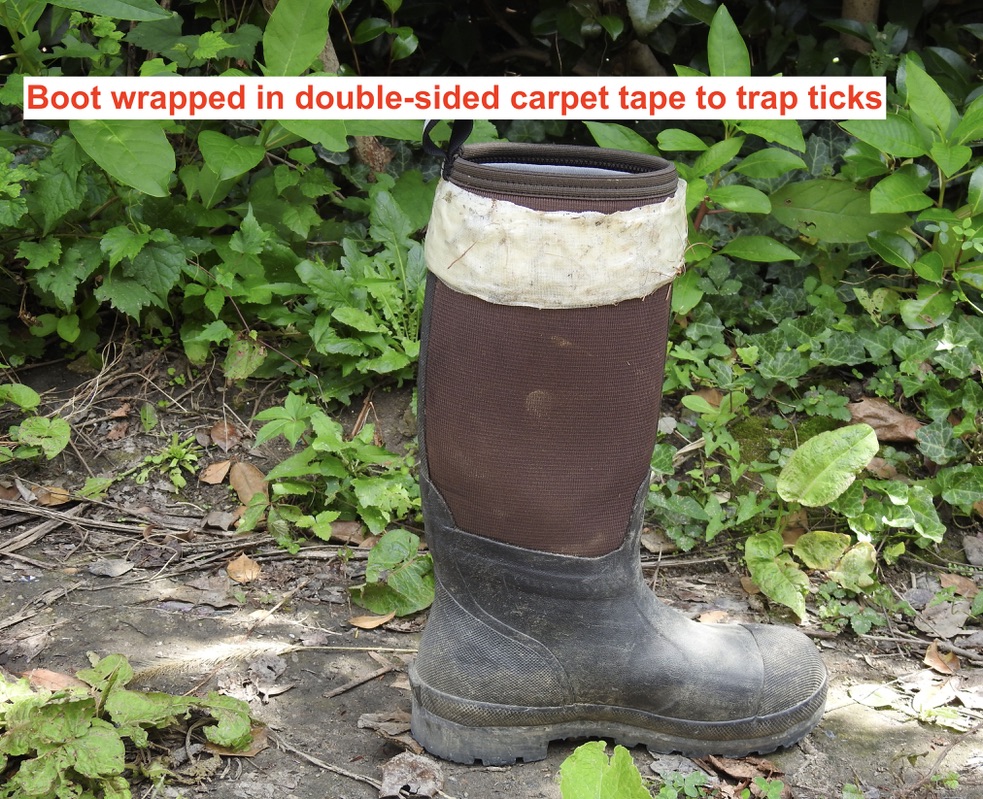
Wrap the tops of your boots with double-sided carpet tape
- Tick crawl up. The tape will trap ticks trying to crawl up your legs.
- I use two types of double-sided carpet tape:
- If you don’t wear boots, you can wrap your pants with tape, but do so at different heights so your legs don’t stick together.
Source: Holly Tuten, tick expert

Tick-repellent Clothing Option #1:
Buy permethrin-treated clothing and gear
Professionally treatment last longer than home treatments, but keep in mind that the permethrin does wash out eventually. A popular brand is Insect Shield (see right). These companies also sell treated clothes:




Tick-repellent Clothing Option #2:
Have your own clothes treated
Use a service that treats your clothing with permethrin, like Insect Shield.
Tick-repellent Clothing Option #3:
Treat Your Clothes and Gear with Permethrin Yourself
Treat boots, clothes, and camping gear with products containing 0.5% permethrin (7). Sawyer Premium Insect Repellent is a popular choice.
- You should not apply permethrin to your skin or underclothes.
- Permethrin can be toxic to some pets, such as cats.
- Be sure to follow the instructions provided when applying permethrin.
Learn about permethrin and permethrin treated clothes from TERC.


Source: CDC
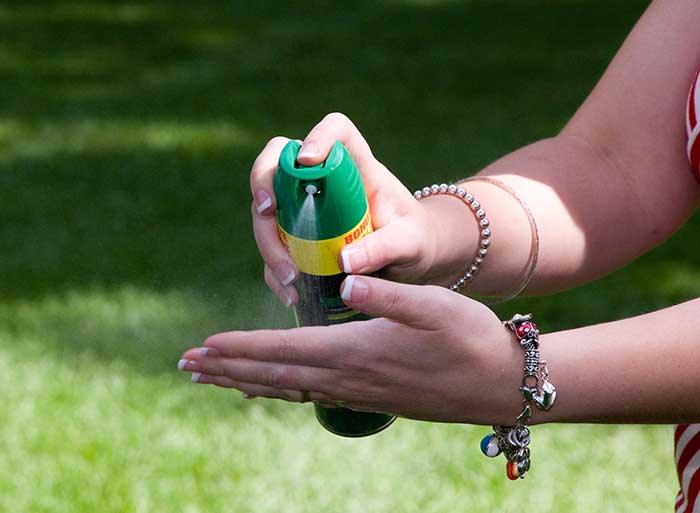

Source: CDC
Use Repellents on Your Body and Clothes
- Use EPA-registered insect repellents, such as DEET, picaridin, IR3535, Oil of Lemon Eucalyptus (OLE), para-menthane-diol (PMD), or 2-undecanone
- More information about these repellents can be found on the EPA site.
- Some repellents can be used on your body, some on your clothes, and some on both.
- Do not use insect repellent on babies younger than 2 months old.
- Do not use products containing OLE or PMD on children under 3 years old.
- This EPA tool can help you find the right repellent for you.
DEET Guidelines
- Higher concentrations of DEET offer longer protection. For example, 30% DEET will protect the user for an estimated 6 h, whereas 5% DEET offers 2 h of protection.
- Do NOT use DEET on children 2 months old or younger.
- Use DEET concentrations of 10% or less on children less than 12 years old.
- DEET can corrode some synthetic fabrics, like Gore-tex™.
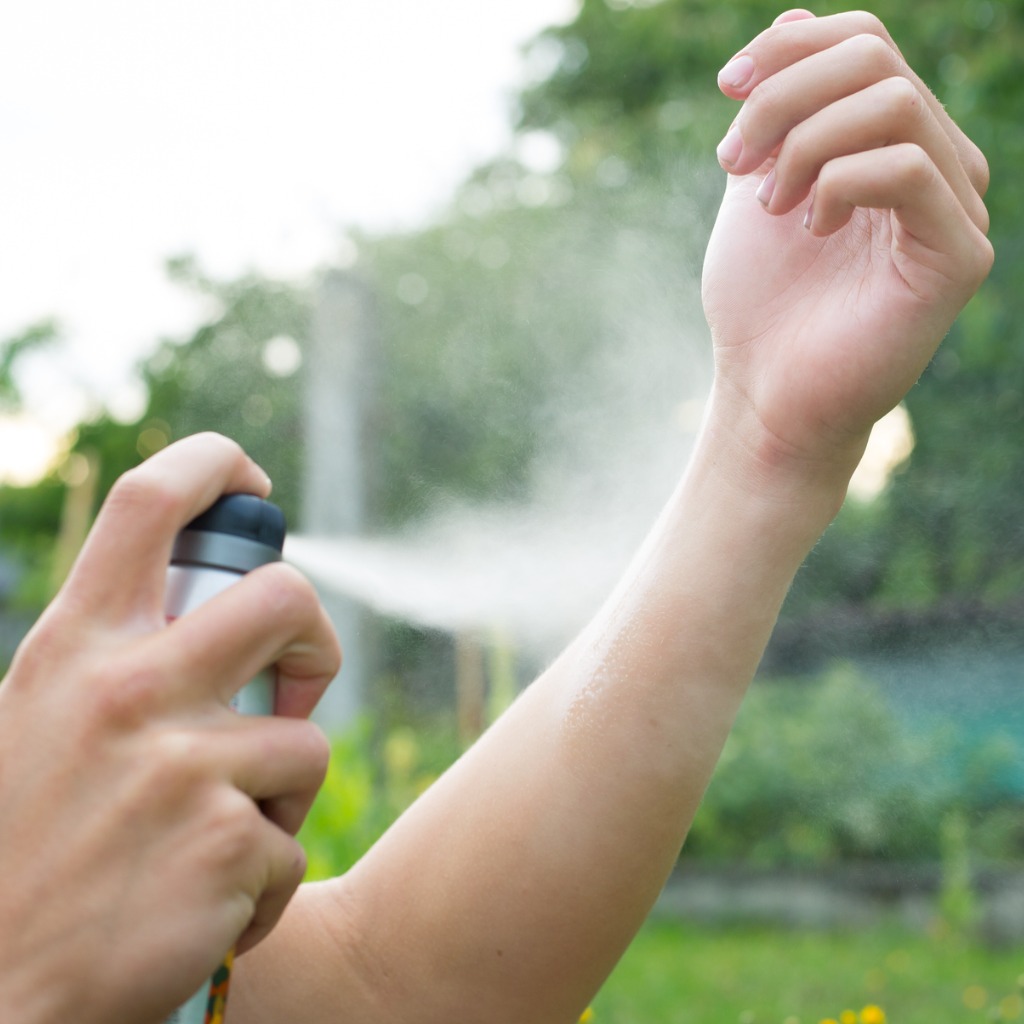

For more information about which repellents are effective against ticks read The Most Effective Tick Repellents for Humans (and Dogs), According to Science
Watch Where You Walk and Sit
- Avoid wooded and brushy areas with high grass and leaf litter (7).
- Walk in the center of trails (7).
- Keep moving. If you stay still for too long, Lone Star Ticks will detect your odor and come find you.
- Don’t linger in one spot for too long.
- Don’t sit in tick-infested areas.
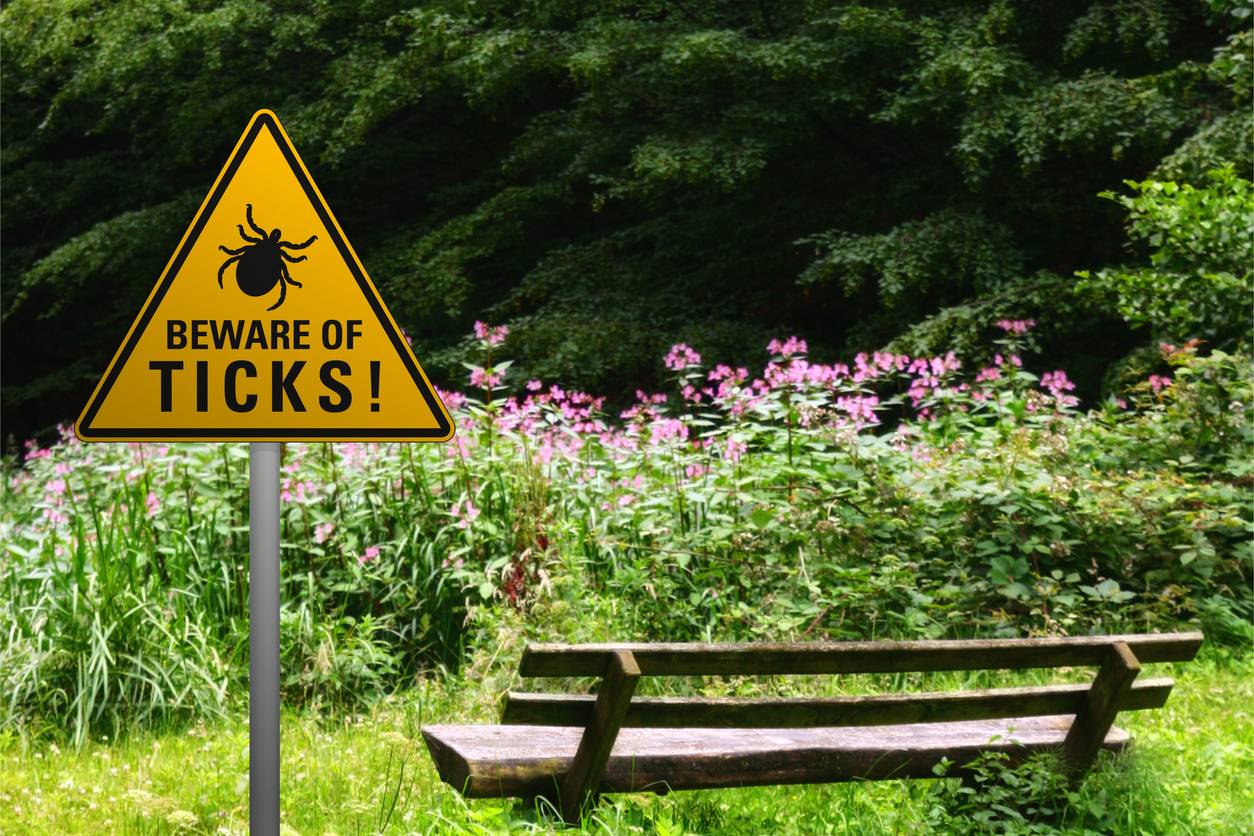



Check for Ticks Frequently
- While outdoors, check yourself and your children for ticks frequently.
Use a Lint Roller
- Some people find it helpful to run a lint roller over their clothes to pick up small ticks that they don’t see.
- This is especially helpful in the spring and fall, when tiny tick nymphs and larvae are most abundant.
When You Get Home
- When you get home, do a full-body tick check (7).
- Remove any ticks you find immediately (7).
- Check your clothes, pets, and gear for ticks (7).
- Get a shower as soon as possible to wash off unattached ticks (7).
- Tumble your clothes in a clothes dryer on high for at least one hour before washing them to kill Lone Star Ticks. Washing clothes alone is not an effective way to kill lone star ticks (14). Heat kills ticks, not water.
- See What to Do If You Are Bitten by a Tick for more information about proper tick removal and what to do next.
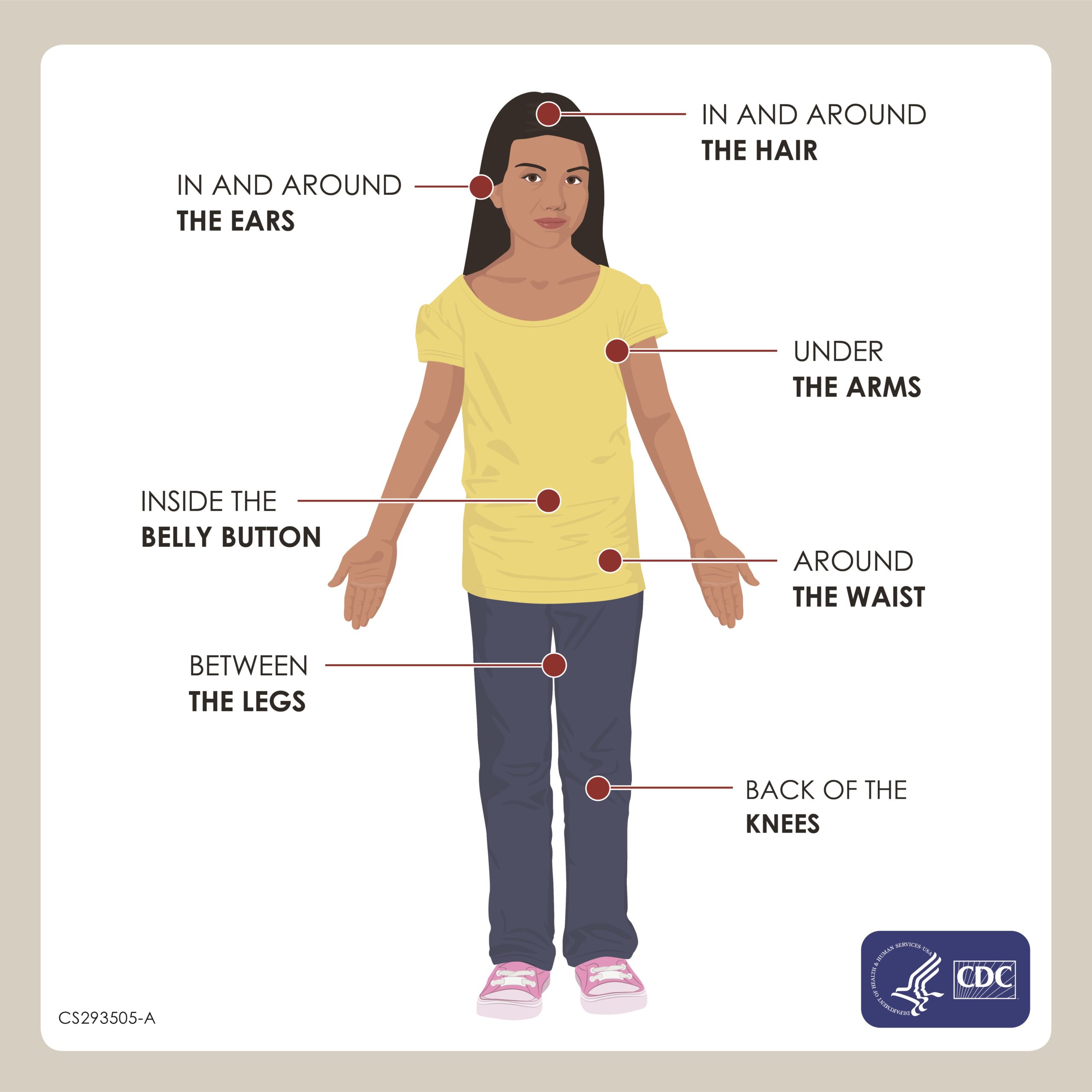

Source: CDC Tick Removal
Tick Tips
from Holly Tuten, the Vector Collector
Follow Holly Tuten on Social Media
More Information


Ticks and Alpha-gal Syndrome→


What to Do If You Are Bitten by a Tick→


Ticks and Pets→
For more detailed information about ticks and how to cope with them go to the following websites:
CDC
TickEncounter
TIC NC
References–in development
1. Hashizume H, Fujiyama T, Umayahara T, Kageyama R, Walls AF, Satoh T. Repeated Amblyomma testudinarium tick bites are associated with increased galactose-α-1, 3-galactose carbohydrate IgE antibody levels: a retrospective cohort study in a single institution. Journal of the American Academy of Dermatology. 2018 Jun 1;78(6):1135-41.
2. Commins SP. Diagnosis & management of Alpha-gal Syndrome: Lessons from 2,500 patients. Expert Review of Clinical Immunology. 2020 Jun 25. Forthcoming.
3. Kim MS, Straesser MD, Keshavarz B, Workman L, McGowan EC, Platts-Mills TA, Wilson JM. IgE to galactose-α-1, 3-galactose wanes over time in patients who avoid tick bites. The Journal of Allergy and Clinical Immunology: In Practice. 2020 Jan 1;8(1):364-7.
4. Paddock CD, Yabsley MJ. Ecological havoc, the rise of white-tailed deer, and the emergence of Amblyomma americanum-associated zoonoses in the United States. InWildlife and emerging zoonotic diseases: the biology, circumstances and consequences of cross-species transmission 2007 (pp. 289-324). Springer, Berlin, Heidelberg.
5. Lone Star Ticks in New Jersey: Risk, Ecology, and Prevention. Rutgers New Jersey Agricultural Experiment Station.
6. Molaei, G. et al. “Bracing for the Worst — Range Expansion of the Lone Star Tick in the Northeastern United States.” (2019). N Engl J Med; 381:2189-2192
7. CDC Ticks
8. Monzón, J. D., et al. (2016). “Population and Evolutionary Genomics of Amblyomma americanum, an Expanding Arthropod Disease Vector.” Genome Biology and Evolution 8(5): 1351-1360.
9. University of Rhode Island Tick Encounter Resource Center
10. “lone star tick – Amblyomma americanum (Linnaeus)”. entnemdept.ufl.edu.
11. Tick-Borne Infections of North Carolina, Inc.
12. Sonenshine DE. Range expansion of tick disease vectors in North America: implications for spread of tick-borne disease. International journal of environmental research and public health. 2018 Mar;15(3):478.
13. Woodson MM. Retrieved from: The low-down on ticks. Part 1A, Biology Q&A. NY State IPM Progeam. Cornell University. 2018 June.
14. Carroll JF. A cautionary note: survival of nymphs of two species of ticks (Acari: Ixodidae) among clothes laundered in an automatic washer. Journal of medical entomology. 2003 Sep 1;40(5):732-6.
15. Platts-Mills TA, Commins SP, Biedermann T, van Hage M, Levin M, Beck LA, Diuk-Wasser M, Jappe U, Apostolovic D, Minnicozzi M, Plaut M. On the cause and consequences of IgE to galactose-α-1, 3-galactose: a Report from the National Institute of Allergy and Infectious Disease Workshop on Understanding IgE-Mediated Mammalian Meat Allergy. Journal of Allergy and Clinical Immunology. 2020 Feb 10.
16. Ho BM, Davis HE, Forrester JD, Sheele JM, Haston T, Sanders L, Lee MC, Lareau S, Caudell M, Davis CB. Wilderness Medical Society Clinical Practice Guidelines for the Prevention and Management of Tick-Borne Illness in the United States. Wilderness & Environmental Medicine. 2021 Oct 9.
17. Merten HA, Durden LA. A state-by-state survey of ticks recorded from humans in the United States. J Vector Ecol. 2000;25(1):102-113.
All the information on alphagalinformation.org is provided in good faith, but we, the creators and authors of the Alpha-gal Information website offer no representation or warranty, explicit or implied, of the accuracy, adequacy, validity, reliability, availability, or completeness of any information on this site. Under no circumstances should we have any liability for any loss or damage incurred by you as a result of relying on information provided here. We are not physicians or medical professionals, researchers, or experts of any kind. Information provided in this website may contain errors and should be confirmed by a physician. Information provided here is not medical advice. It should not be relied upon for decisions about diagnosis, treatment, diet, food choice, nutrition, or any other health or medical decisions. For advice about health or medical decisions including, but not limited to, diagnosis, treatment, diet, and health care consult a physician.
READ FULL DISCLAIMER>
